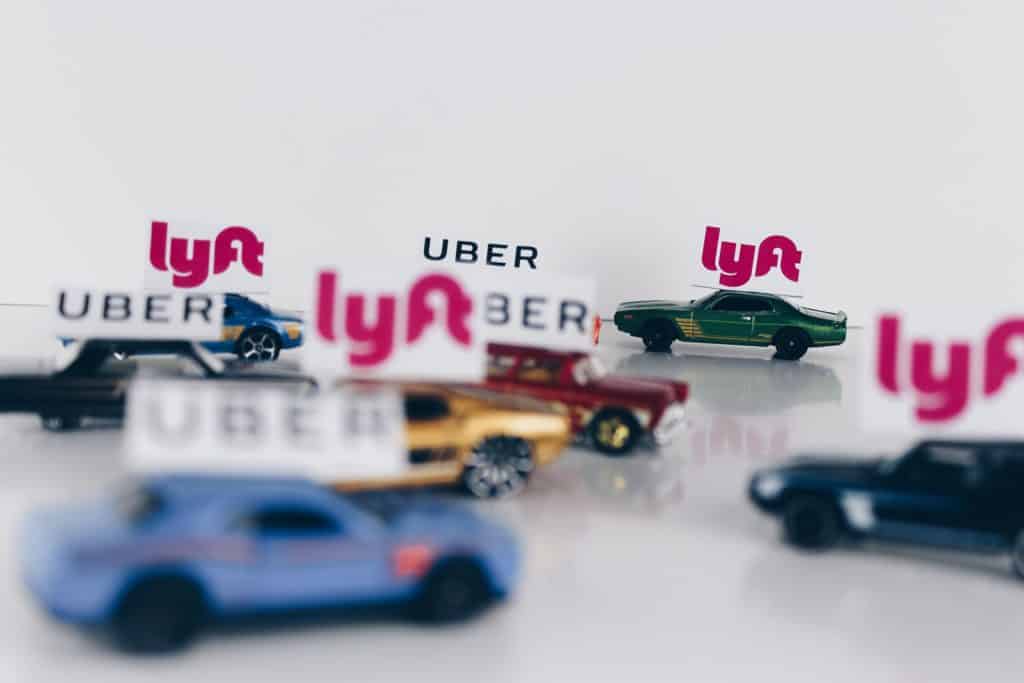Uber is set to announce it’s IPO very soon. Various publications have stated that Uber hopes to value it’s initial offering at about 100 billion squids. Where squids are in fact US Dollars and where if this valuation makes sense then the entire world has gone mad and should be overrun by 100 billion squid.
Not that Stewy here is the first to question the sanity of buying into a company that has yet to generate a single cent of profit in the 10 years of its existence. But one has to question how Uber has squandered so much money on essentially an app and some cloud servers. Sure I’m over simplifying here, but the point is the infrastructure that Uber has had to build out is nothing near to what a company like Amazon was attempting to build out when it was losing money for the first 10 years of its existence.
What is Uber’s rationale for its 100 billion dollar valuation? Uber claims it is going to completely reshape and dominate all transportation and delivery services. That is their claim. In Uber’s eyes most of us won’t own cars in the near future. Most investment in public transportation will decline over time. Uber will be who we turn to when we have to lift our corpulent self indulgent selves out of our recliners to head over to our friend’s house to sit in their recliner. Then binge watch 12 seasons of some just released Netflix series while we order up Uber Eats to deliver artisan baked, gluten free, farm raised, soy wheatgrass burgers.
All of this is fine, except that Uber doesn’t actually make money from its rideshare business.
Hubert Horan, a transportation industry consultant that studied Uber's 2015 released financial data, showed that passengers were only paying 41% of what it actually cost to provide the ride.
Reuters News
Uber’s business model is based on providing fares to riders that are so low Uber can’t generate any profit off the fares. Keeping with our Amazon comparison one can state that Amazon also went over 10 years where it was losing money. But Uber’s losses aren’t the same as Amazon’s.
Amazon, in general, was actually making money from the prices it was selling products for. It was making enough to pay for the existing infrastructure and employees it took to sell those products. The reason they were losing money was they were spending so much money on future infrastructure.
Uber would like you to believe that is also the reason they are losing money. But that’s not the reason. Uber simply isn’t making money off it’s actual fares. In other words it costs Uber more to provide a passenger with a ride, than what that passenger is paying. The money Uber is spending buying up competitors, electric scooter companies, and developing autonomous vehicles is just adding to the losses it would have incurred anyways.
Uber counters that it WILL eventually make money. Not by increasing fares but by eliminating drivers. In the meantime they are hoping to drive every other form of transportation out of business by charging a rate no one can compete with. Unless they are willing to lose money as well. You know, like Lyft who has also never generated any profits either.
Fear not this will all work out once Uber eliminates all those overpaid drivers!
Driver’s are a large part of Uber’s expenses. But they should be. They are the only part of Uber’s business model that currently brings money into Uber. Replacing drivers with autonomous vehicle’s would eliminate a huge expense. But it would suddenly create new, very large expenses as well. You see those drivers bring a huge amount of infrastructure with them. At little or no expense to Uber.
The Uber driver brings with them, on average, a $20,000 investment (in a car), and then shoulders all the insurance, registration, gas, oil, tires, brake, dent, scratch (yes they require drivers to keep cars relatively dent and scratch free or they deactivate them) and depreciation and storage expenses.
In exchange for all of that Uber often pays the driver less than $5 per ride.
If you use Uber, believe it or not, the driver does NOT get the amount YOU paid for the ride. Stewy here is amused at the percent of rideshare riders that assume that the driver gets all (really?) or most of the money the passenger paid Uber for their ride. If drivers were getting paid a huge amount of each fare, then Uber getting rid of drivers might work to make Uber profitable. But the amount Uber pays drivers is far less than most people realize.
Ten years ago Uber paid drivers 75% of every fare. That was ten years ago and somehow Uber has kept that narrative alive. Keeping that narrative alive is important to Uber. First it is how they convince city councils and other local politicians to let them operate in their jurisdictions. Admitting that the jobs you provide barely cover the expenses of the costs of providing those rides probably would cause people to actually look into all the cab companies going bankrupt and cab drivers surging to the top of the list of professions committing suicide. I digress.
The reality is that Uber has reduced what they pay drivers pretty much every year they have been in business. They currently have in place a formula that often takes as much as 60 to 70% of many fares. It is on “short rides” that Uber claims such a high percentage of the passenger’s fare. But “Short rides” comprise the majority of rides Uber delivers according to, well, Uber.

So what do drivers get paid?
It varies by market, but using the Phoenix market as an example, on rides where the passenger paid $10 or less the driver is making about $3. These are the so called “short rides”. Of course by short don’t get the idea that drivers can bang out a bunch of these “short rides” in an hour. Many “short rides” can take 15 to 20 minutes to complete as the driver has to drive to the passenger and then often wait for the passenger and then drive the passenger to their destination. The beauty for Uber is it does not pay the driver to GET to the passenger, only to transport the passenger. So Uber absorbs ZERO of the cost for getting the driver and their vehicle to the passenger. Most passengers are 5 to 10 minutes away from the driver. Some are 15 to 20 minutes away.
That means that for “short rides” the driver shoulders the expense for 50 to 80% of the time needed to complete that ride at NO COST to Uber. That all changes if Uber suddenly owns the vehicles that are making these pickups.
If Uber is going have to purchase it’s own vehicles, they go from zero car expenses to the costs associated with purchasing, maintaining, insuring and providing fuel for those vehicles. They also will have to pay for land and structures to house tens of thousands (or possibly millions) of vehicles, and then hire staff to wash and vacuum them everyday. There is also the added expense of now being responsible for accidents and everyday dings scrapes and cracked windows, etc. Maybe, and it’s a big maybe, all of this expense will be less than what they currently pay drivers . But maybe it won’t or at least not enough less that they can turn a profit at their current fares.
So it begs the question, why not just raise fares?
Competition. Lots of competition. I’m not really referring to Lyft, though they have been chewing into Uber’s dominance.
Uber’s profitability relies on autonomous vehicles. But that is where the competition is the fiercest. Auto manufacturers have been pouring billions into autonomous cars for far longer than Uber. And Uber’s own autonomous car program has not gone well. They were kicked out of Arizona and had to move their autonomous car program to Pennsylvania. This after one of their autonomous cars killed a pedestrian in Tempe, AZ.
Furthermore the cutting edge of Uber’s app was, well, cutting edge ten years ago. Now its not nearly as difficult for developers to write their own ride share apps. There are dozens of competing Ride Share Apps already available. TotalRide, ZimRide, Hitch, Sidecar and Carma just to name a few. Then you have the auto manufacturers.
Tesla has already announced that it has developed an app for its Tesla owners that will allow them to send their self driving Tesla car out to act as a rideshare car. When and if Tesla ever rolls out its fully self driving software, Tesla owners will be able to send their autonomous vehicles out to earn their owner’s money. You can be sure that EVERY auto manufacturer that eventually produces autonomous vehicles will offer their owners the same option.
Then there’s Waymo. Waymo owned by Google. Yeah that Google with billions and billions of ACTUAL PROFIT. Waymo ALREADY has a fleet of fully self driving hybrid minivans. There are already dozens of fully autonomous Waymo vehicles picking up passengers in Phoenix, Arizona.
Waymo has already beaten Uber in the race to launch autonomous vehicles. Waymo has another advantage as well. Uber (and Lyft) rely on Google’s, Google Map software to provide navigation for their drivers. Yeah, that Google. The one that owns a rideshare company that already has fully autonomous vehicles called Waymo. Why does this matter? Google has access to EVERY rideshare ride that has EVER been given by both Uber and Lyft. They know everything. I can’t think of another industry where one of the competitors knows the details about every single transaction of its rivals.
So why does this matter? How much would it cost to hire millions of drivers and figure out the patterns of the rideshare industry in advance of launching your own company? How much is it worth to know precisely where best to deploy your own vehicles, at what times of the day? To have detailed, very granular maps of demand in cities around the world? I don’t know exactly what it’s worth, but I’ll hazard a guess. A crap load.
Why do I suspect Google is gleaning data from Uber and Lyft’s use of their mapping software?
Google has been a major investor in both Uber and Lyft. Now, of course. they aren’t going to publicly disclose that this was just a clever way of hoovering up rideshare data. They are going to state it was simply to cover their bets. And it is, but it is also a clever way to allow Uber and Lyft’s other investors help pay for the data Google wants. We are in an economy after all where data is king.
Stewy’s Uber IPO advice? Wait at least 6 months, maybe a year and see what happens to the price of their stock. People that just bought into Lyft’s IPO are probably wishing they had waited.
In the meantime if you want to remain in the One Percent, or perhaps move in that direction, invest in a company called Alphabet. You know, the one that owns Google which in turn owns Waymo.


This Post Has 2 Comments
Pingback: Uber Stock Tanks – NewsStew
One of the more thoroughly thought out articles detailing the many obstacles Uber has to overcome. If you bought Uber stock and then read this later you probably were a little queasy.